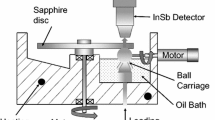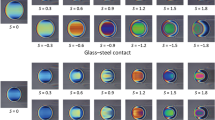Abstract
INTERFEROMETRY has been used in both surface chemical investigations1 and lubrication studies2 to measure the thickness of thin hydrocarbon films. Until now experiments have suffered from the disadvantage of being restricted to films thicker than a quarter of a wavelength and this has meant that films of less than about 900 Å thick could not be investigated. Fig. 1A shows the general arrangement of the apparatus used by Gohar and Cameron2 in their studies of the elastohydrodynamic lubrication of a hard steel ball. Partial reflexion occurred at the diamond (or high refractive index glass) to oil interface because of the difference in refractive indices. Better fringe definition can be obtained by the use of optical crown glass (µ≃1.5) which has been vacuum coated3 with a quarter wavelength film of titanium dioxide, as is shown in Fig. 1B. The interference pattern gives a direct measure of the lubricant film contours under diverse conditions.
Similar content being viewed by others
References
Zakhavaeva, N. N., Deryagin, B. V., Khomntov, A. M., and Andreev, S. V., Research in Surface Forces (edit. by Deryagin, B. V.), 2 (Consultants Bureau, New York, 1966).
Gohar, R., and Cameron, A., Proc. Roy. Soc., A, 291, 520 (1966).
Holland, L., Vacuum Deposition of Thin Films (Chapman and Hall, London, 1956).
Author information
Authors and Affiliations
Rights and permissions
About this article
Cite this article
WESTLAKE, F., CAMERON, A. Fluid Film Interferometry in Lubrication Studies. Nature 214, 633–634 (1967). https://doi.org/10.1038/214633a0
Received:
Issue Date:
DOI: https://doi.org/10.1038/214633a0
- Springer Nature Limited
This article is cited by
-
Drop-on-Demand Printing as Novel Method of Oil Supply in Elastohydrodynamic Lubrication
Tribology Letters (2019)
-
Theoretical Study on the Interferometry of Thin EHL Film Measurement
Tribology Letters (2008)





